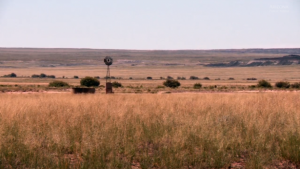Source: whitewolfpack.com
Published: July 15, 2012

Many Navajo Nation residents must drive 45 minutes to water towers such as these for daily use.
Documentary Profiles Solar Water-Purification Program on Navajo Nation
A new water-purification system using solar power to purify contaminated groundwater holds promise for solving water problems not only on the Navajo Nation, where it is being tested, but for many other indigenous communities as well.
Scientists from the University of Arizona and the U.S. Department of the Interior Bureau of Reclamation are working on a project innovative enough to have inspired a documentary, in fact. Its goal is to provide cheap, off-the-grid water for communities that do not have access to any.
Although many in the U.S. take clean water for granted and consider it a basic human need, 40 percent of the population on some parts of the Navajo Nation does not have access to potable water. That doesn’t just mean drinking water. It’s not even good enough to bathe in, wash dishes, irrigate a vegetable garden or quench the thirst of livestock. Some of the water issues are rooted in the natural geology of the 24,000 square miles spanning three states that is home to more than 175,000 Navajos on the largest reservation-based native nation in the U.S.
One of the greater water concerns comes from nature itself, as most of the groundwater on the Nation comes through a salt cavern and as a result of that journey produces liquid with high levels of salinity and other particulates, making the brackish water impossible to drink.
Recognizing that many Navajos, like Rosie Sekayumptewa, have to make a 45-mile roundtrip every few days to haul two 55-gallon containers of water from a communal well—an odious task at best—scientists from the University of Arizona and the Bureau of Reclamation took on a project to design and build an off-the-grid prototype solar solution that would purify existing undrinkable water.

“Our co-generation solar system will produce heat and electricity to run the entire desalination system without being tied to the grid,” said Ardeth Barnhart, program director for renewable energy and a principal investigator for scientists who work at the University of Arizona Institute of the Environment. “While part of the technology development is to provide clean water on a daily basis, we designed this to be an economic development tool where communities could replicate and deploy these systems at their discretion.”
Conversations about cost are still confidential, but Barnhardt says, “It’ll be cheaper than what they’re paying for water now.”
The effort is so innovative and promising that it inspired Tom Kleespie, a veteran producer of documentaries for Arizona Public Media and Dustinn Craig, to showcase the project in Seeking Water from the Sun, a 30-minute documentary detailing the designing and building of this solar-powered water distillation prototype.
“We filmed for almost two years because the first prototype didn’t work the way they wanted, and they had to start over,” Kleespie said. “This project is somewhat unique in that it presented its own challenges because the coordinators learned as they went along. They’d try this and it wouldn’t work, so they’d try something different. It was interesting to watch the evolution of the project as it went along because the story itself evolved as they succeeded or failed at certain things.”
With filming input and cooperation from various Navajo Nation Chapters, agencies and community members, the PBS documentary began to take shape.
“The project has been well received by the Navajos themselves as a model to solve these kinds of contaminated water problems,” Kleespie said. “My biggest challenge was making sure the story was told from a Navajo point of view.”
Fellow producer Craig (Navajo/White Mountain Apache), narration by Chinle Navajo native Norman Patrick Brown and a musical score by Mary Redhouse (Dine/Navajo tribe) added authenticity, Kleespie said.
The filmmakers had to wrap before the working prototype was finished in order to meet a broadcast deadline. But Barnhart indicates that things are currently good to go.
“The prototype has been through feasibility testing and we know it works,” Barnhart said. “Next step is to install the system on Navajo Land, first the solar-powered water pumps in July with the initial unit hopefully operational in September.”
Initial goal of the project will be to produce 1,000 gallons a day of livestock-quality water—a far cry from the original prototype model that produced 10 gallons daily. With the first unit installation at the Leuppe Well site, its expected travel time to haul water will be cut from a 45-minute roundtrip to 10 to 15 minutes.
The best part is that it does not require fancy, untested technology, which means it could be employed elsewhere.
“The solar energy technology is already available, and the novel part of our system is the membrane technology piece,” said Barnhart. “This is transferrable technology that can be used anywhere in the world that has high salinity water.”
Here’s a promo of the documentary, and the full version can be viewed at Arizona Public Media, a division of PBS.
VIDEO Seeking Water From The Sun Promo
